Influence of the Protein-Based Emulsions on the Rheological, Thermo-Mechanical and Baking Performance of Muffin Formulations
Abstract
:1. Introduction
2. Materials and Methods
2.1. Materials
2.2. Chemical Composition
2.3. Preparation of Emulsions
2.4. Fundamental Rheological Measurements on Emulsions
2.5. Thermo-Mechanical Behavior
2.6. Preparation of the Muffins
2.7. Characterization of the Muffins
2.8. Sensory Analysis Test
2.9. Statistical Analysis
3. Results and Discussion
3.1. Rheological Properties of the Emulsions
3.2. Rheological Properties of the Doughs
3.3. Muffin Characterization
4. Conclusions
Author Contributions
Funding
Institutional Review Board Statement
Informed Consent Statement
Data Availability Statement
Conflicts of Interest
References
- Hussien, H.A. Using vegetable puree as a fat substitute in cakes. Int. J. Nutr. Food Sci. 2016, 5, 284–292. [Google Scholar] [CrossRef] [Green Version]
- Colla, K.; Costanzo, A.; Gamlath, S. Fat replacers in baked food products. Foods 2018, 7, 192. [Google Scholar] [CrossRef] [PubMed] [Green Version]
- Azmoon, E.; Saberi, F.; Kouhsari, F.; Akbari, M.; Kieliszek, M.; Vakilinezam, A. The effects of hydrocolloids-protein mixture as a fat replacer on physicochemical characteristics of sugar-free muffin cake: Modeling and optimization. Foods 2021, 10, 1549. [Google Scholar] [CrossRef]
- Rodriguez-Sandoval, E.; Prasca-Sierra, I.; Hernandez, V. Effect of modified cassava starch as a fat replacer on the texture and quality characteristics of muffins. J. Food Meas. Charact. 2017, 11, 1630–1639. [Google Scholar] [CrossRef]
- Fernandes, S.S.; de las Mercedes Salas-Mellado, M. Addition of chia seed mucilage for reduction of fat content in bread and cakes. Food Chem. 2017, 227, 237–244. [Google Scholar] [CrossRef]
- Zahn, S.; Pepke, F.; Rohm, H. Effect of inulin as a fat replacer on texture and sensory properties of muffins. Int. J. Food Sci. Technol. 2010, 45, 2531–2537. [Google Scholar] [CrossRef]
- Martínez-Cervera, S.; Salvador, A.; Muguerza, B.; Moulay, L.; Fiszman, S.M. Cocoa fibre and its application as a fat replacer in chocolate muffins. LWT-Food Sci. Technol. 2011, 44, 729–736. [Google Scholar] [CrossRef]
- Jeong, S.; Lee, S.; Oh, I. Development of antioxidant-fortified oleogel and its application as a solid fat replacer to muffin. Foods 2021, 10, 3059. [Google Scholar] [CrossRef]
- Manzoor, S.; Masoodi, F.A.; Naqash, F.; Rashid, R. Oleogels: Promising alternatives to solid fats for food applications. Food Hydrocoll. Health 2022, 2, 100058. [Google Scholar] [CrossRef]
- Pehlivanoglu, H.; Ozulku, G.; Yildirim, R.M.; Demirci, M.; Toker, O.S.; Sagdic, O. Investigating the usage of unsaturated fatty acid-rich and low-calorie oleogels as a shortening mimetics in cake. J. Food Process. Pres. 2018, 42, e13621. [Google Scholar] [CrossRef]
- Therdthai, N. Sugar, salt and fat reduction of bakery products. Adv. Food Nutr. Res. 2022, 99, 283–327. [Google Scholar]
- Boye, J.I.; Zare, F.; Pletch, A. Pulse proteins: Processing, characterization, functional properties and applications in food and feed. Food Res. Int. 2010, 43, 414–431. [Google Scholar] [CrossRef]
- Grossi Bovi Karatay, G.; Rebellato, A.P.; Joy Steel, C.; Dupas Hubinger, M. Chickpea aquafaba-based emulsions as a fat replacer in pound cake: Impact on cake properties and sensory analysis. Foods 2022, 11, 2484. [Google Scholar] [CrossRef]
- Vieira, E.F.; Carvalho, J.; Pinto, E.; Cunha, S.; Almeida, A.A.; Ferreira, I.M. Nutritive value, antioxidant activity and phenolic compounds profile of brewer’s spent yeast extract. J. Food Compos. Anal. 2016, 52, 44–51. [Google Scholar] [CrossRef]
- Tomé, D. Yeast extracts: Nutritional and flavoring food ingredients. ACS Food Sci. Technol. 2021, 1, 487–494. [Google Scholar] [CrossRef]
- SR ISO 712:2005; SR ISO 2171:2002; Romanian Standards Catalog for Cereal and Milling Products Analysis. ASRO: Bucharest, Romania, 2008.
- AACC International. Approved Methods of Analysis, 11th ed.; Method 46-11.02; American Association of Cereal Chemists International: Saint Paul, MN, USA, 2000. [Google Scholar]
- Martínez-Cervera, S.; Salvador, A.; Sanz, T. Cellulose ether emulsions as fat replacers in muffins: Rheological, thermal and textural properties. LWT-Food Sci. Technol. 2015, 63, 1083–1090. [Google Scholar] [CrossRef]
- Banu, I.; Aprodu, I. Investigation on functional, thermo-mechanical and bread-making properties of some white and black rice flours. Appl. Sci. 2022, 12, 4544. [Google Scholar] [CrossRef]
- Aprodu, I.; Banu, I. Rheological, thermo-mechanical, and baking properties of wheat-millet flour blends. Food Sci. Technol. Int. 2015, 21, 342–353. [Google Scholar] [CrossRef] [PubMed]
- Wilde, P.; Mackie, A.; Husband, F.; Gunning, P.; Morris, V. Proteins and emulsifiers at liquid interfaces. Adv. Colloid Interface Sci. 2004, 108, 63–71. [Google Scholar] [CrossRef]
- Manoi, K.; Rizvi, S.S. Emulsification mechanisms and characterizations of cold, gel-like emulsions produced from texturized whey protein concentrate. Food Hydrocoll. 2009, 23, 1837–1847. [Google Scholar] [CrossRef]
- Liu, F.; Tang, C.H. Cold, gel-like whey protein emulsions by microfluidisation emulsification: Rheological properties and microstructures. Food Chem. 2011, 127, 1641–1647. [Google Scholar] [CrossRef]
- Berli, C.L.; Quemada, D.; Parker, A. Modelling the viscosity of depletion flocculated emulsions. Colloid. Surf. A-Physicochem. Eng. Asp. 2002, 203, 11–20. [Google Scholar] [CrossRef]
- McClements, D.J. Emulsion Rheology. In Food Emulsions: Principles, Practices, and Techniques, 2nd ed.; McClements, D.J., Ed.; CRC Press: Boca Raton, FL, USA, 2004. [Google Scholar]
- Moreira, R.; Chenlo, F.; Torres, M.D. Effect of shortenings on the rheology of gluten-free doughs: Study of chestnut flour with chia flour, olive and sunflower oils. J. Texture Stud. 2012, 43, 375–383. [Google Scholar] [CrossRef]
- Zoulias, E.I.; Oreopoulou, V.; Tzia, C. Textural properties of low-fat cookies containing carbohydrate-or protein-based fat replacers. J. Food Eng. 2002, 55, 337–342. [Google Scholar] [CrossRef]
- Dun, H.; Liang, H.; Zhan, F.; Wei, X.; Chen, Y.; Wan, J.; Ren, Y.; Hu, L.; Li, B. Influence of O/W emulsion on gelatinization and retrogradation properties of rice starch. Food Hydrocoll. 2020, 103, 105652. [Google Scholar] [CrossRef]
- Berceli, M.B.; Izsó, E.; Gergely, S.; Salgó, A. Effects of special additives in wheat dough system measured by Mixolab technique. Czech J. Food Sci. 2021, 39, 460–468. [Google Scholar] [CrossRef]
- Ai, Y.; Hasjim, J.; Jane, J.L. Effects of lipids on enzymatic hydrolysis and physical properties of starch. Carboh. Polym. 2013, 92, 120–127. [Google Scholar] [CrossRef]
- Yang, C.; Zhong, F.; Goff, H.D.; Li, Y. Study on starch-protein interactions and their effects on physicochemical and digestible properties of the blends. Food Chem. 2019, 280, 51–58. [Google Scholar] [CrossRef]
- Sudha, M.L.; Leelavathi, K. Influence of micronutrients on rheological characteristics and bread-making quality of flour. Int. J. Food Sci. Nutr. 2008, 59, 105–115. [Google Scholar] [CrossRef]
- Akhtar, S.; Anjum, F.M.; Rehman, S.U.; Sheikh, M.A. Effect of mineral fortification on rheological properties of whole wheat flour. J. Texture Stud. 2009, 40, 51–65. [Google Scholar] [CrossRef]
- Martínez-Cervera, S.; de la Hera, E.; Sanz, T.; Gómez, M.; Salvador, A. Effect of nutriose on rheological, textural and sensorial characteristics of Spanish muffins. Food Bioprocess Technol. 2013, 6, 1990–1999. [Google Scholar] [CrossRef]
- Goyeneche, R.; Agüero, M.V.; Roura, S.; Di Scala, K. Application of citric acid and mild heat shock to minimally processed sliced radish: Color evaluation. Postharvest Biol. Technol. 2014, 93, 106–113. [Google Scholar] [CrossRef]
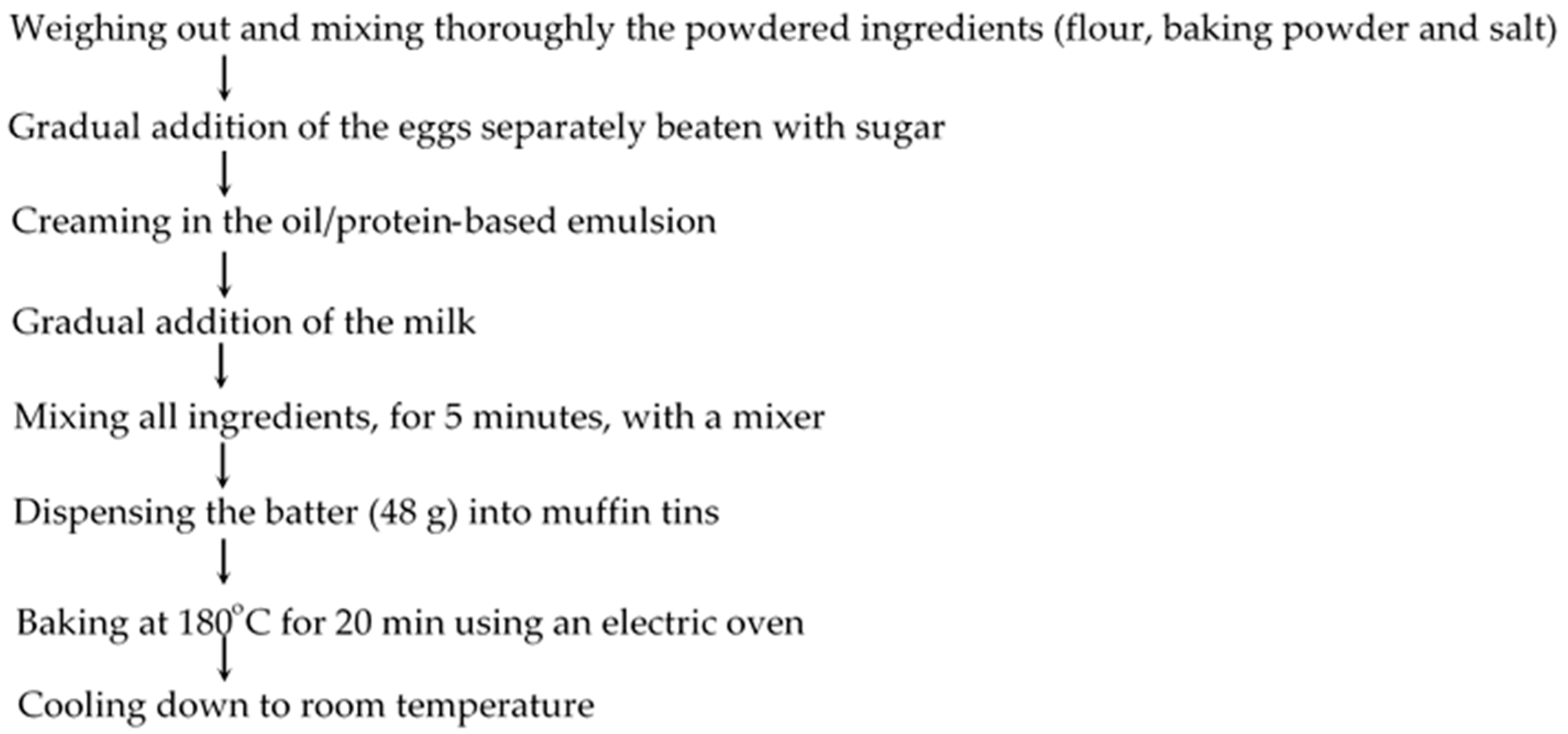
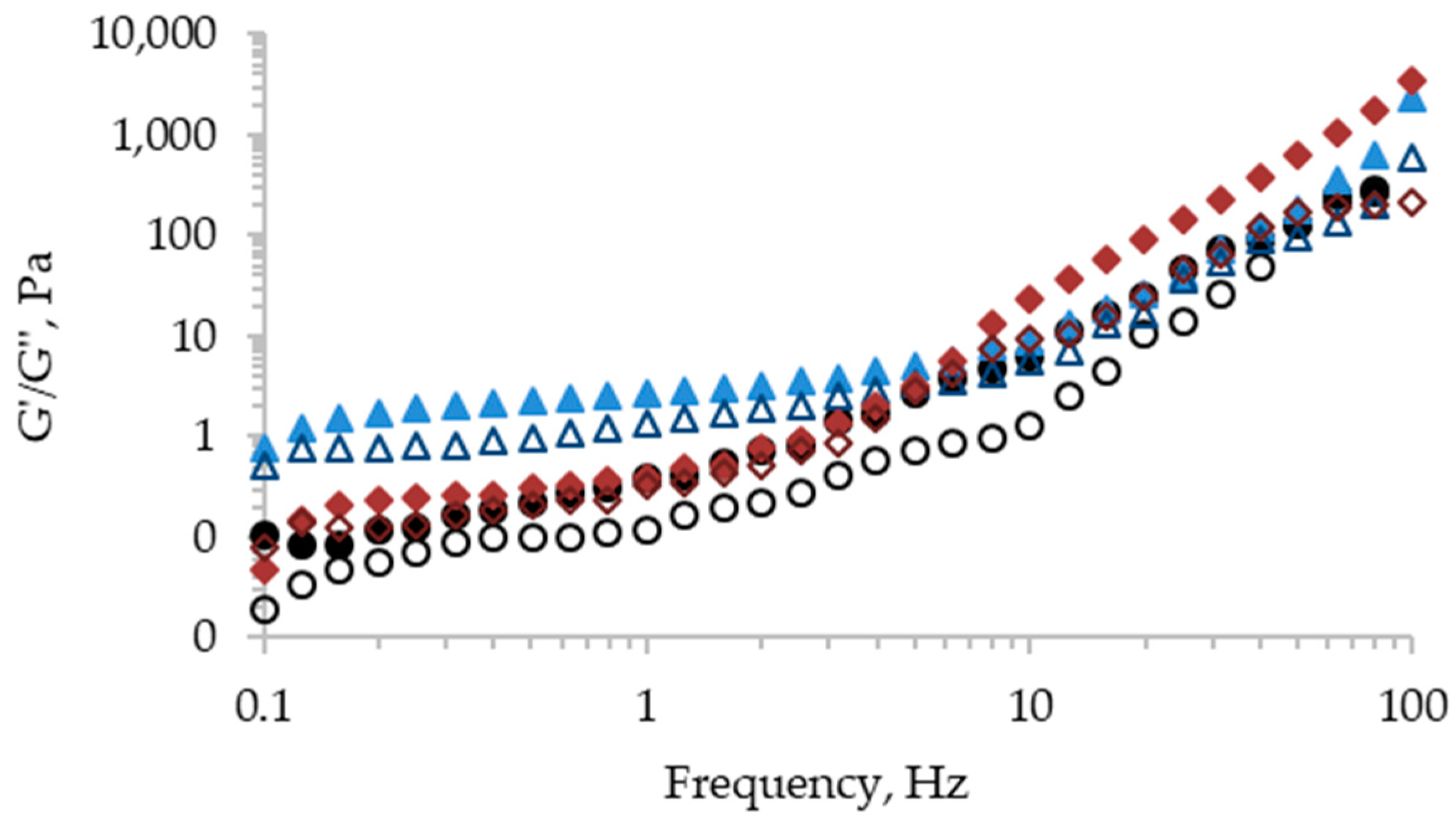
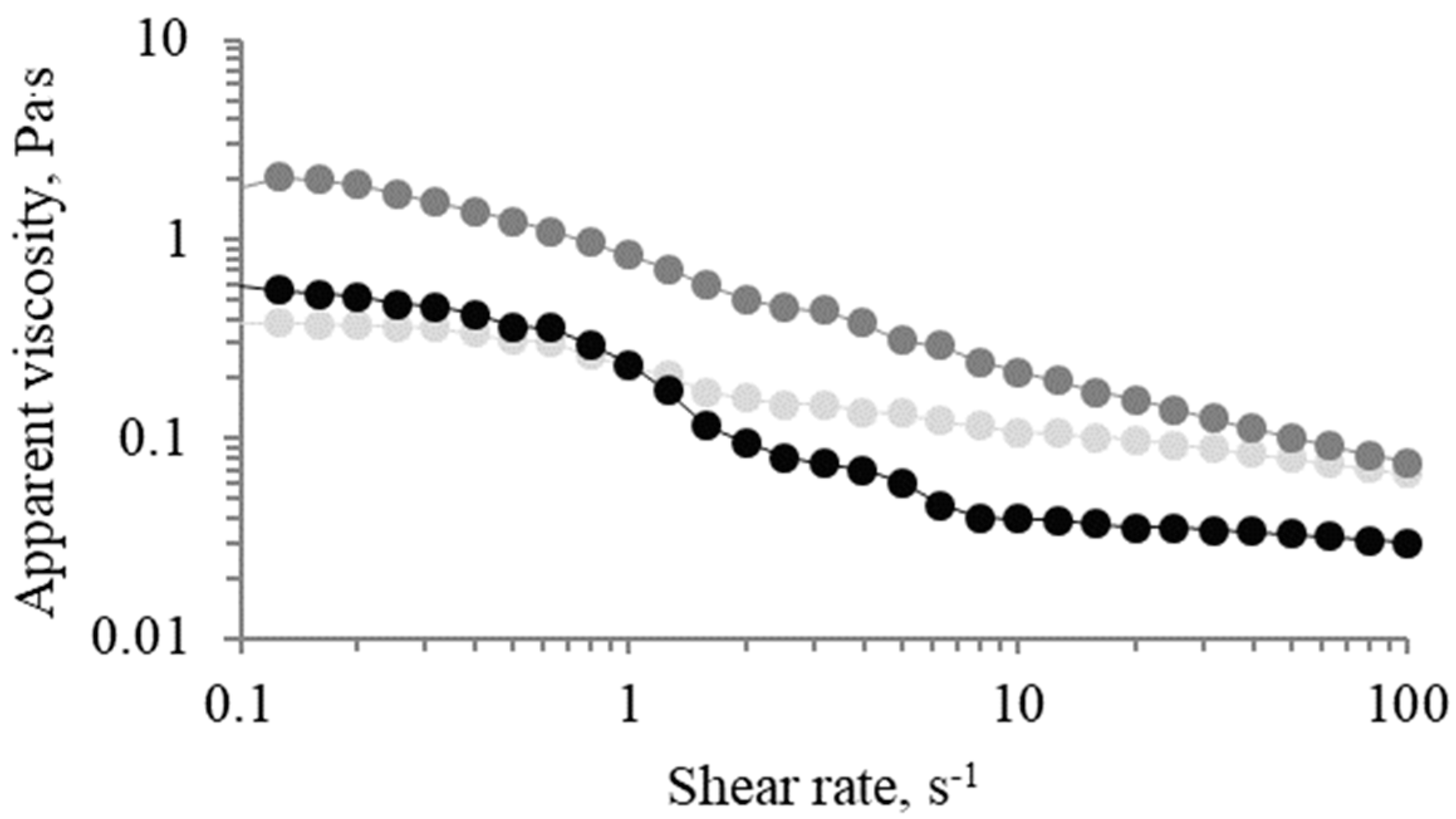
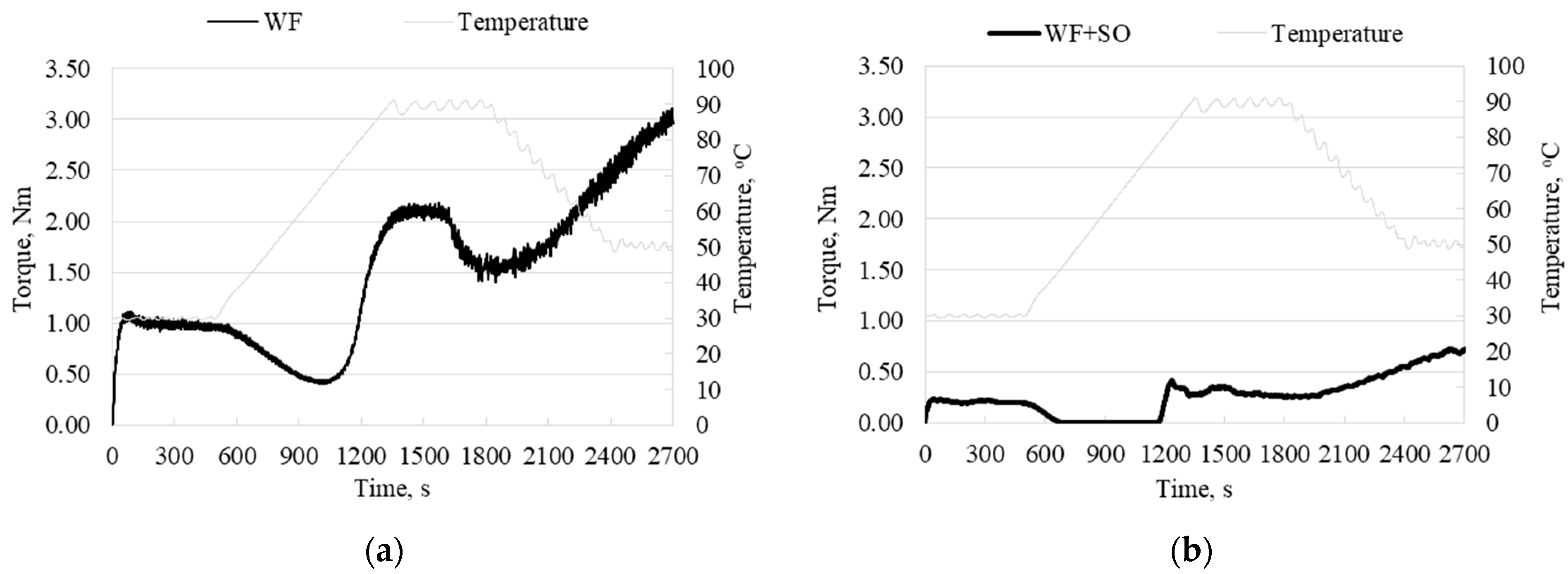
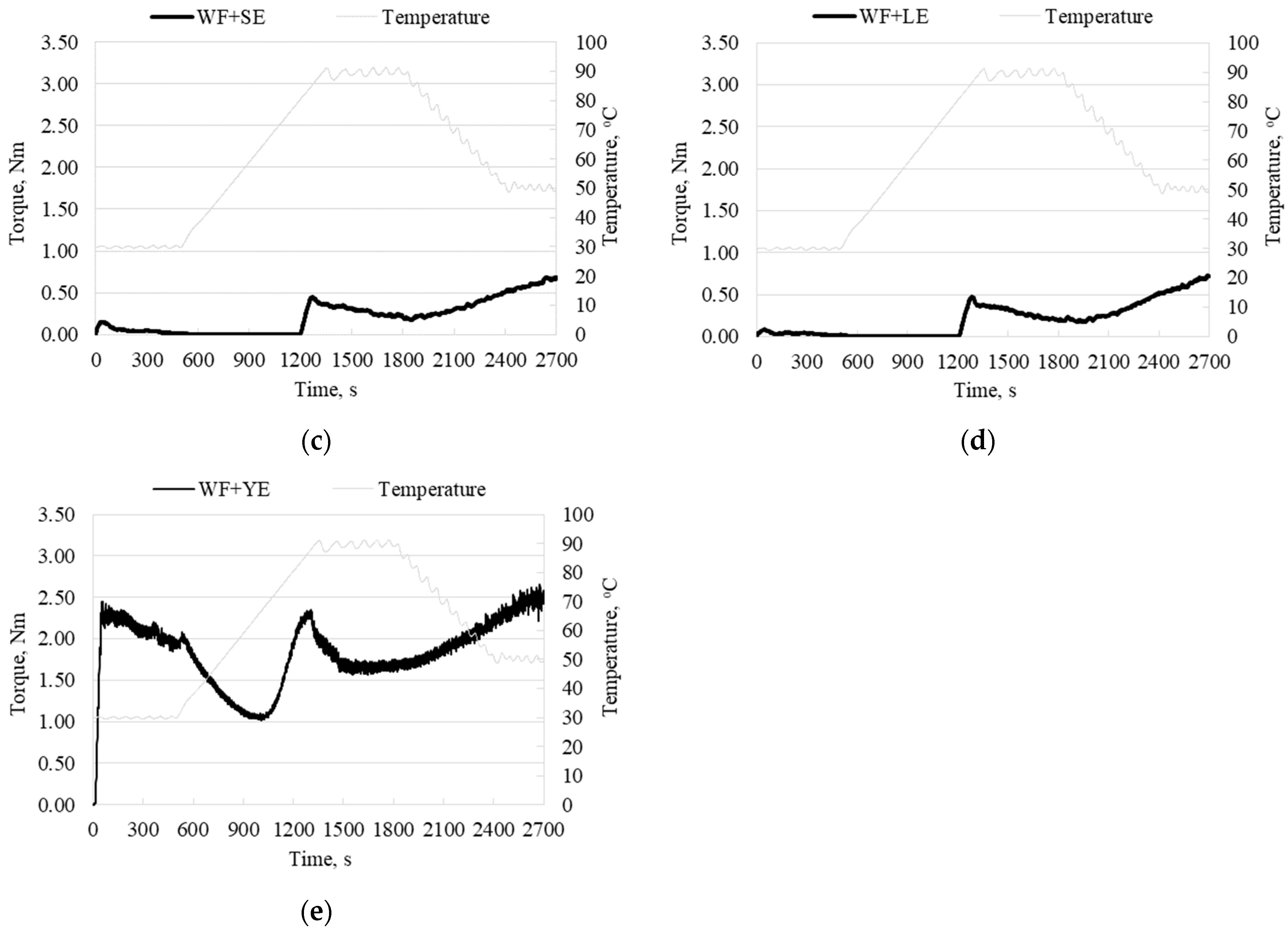

| Ingredients | Muffin Samples | |||
|---|---|---|---|---|
| M | M1 | M2 | M3 | |
| Flour, g | 100 | 100 | 100 | 100 |
| Sugar, g | 100 | 100 | 100 | 100 |
| Egg, g | 80 | 80 | 80 | 80 |
| Milk, ml | 50 | 50 | 50 | 50 |
| Oil, ml | 50 | - | - | - |
| Soy protein emulsion, ml | - | 50 | - | - |
| Lupin protein emulsion, ml | - | - | 50 | - |
| Yeast protein emulsion, ml | - | - | - | 50 |
| Baking powder, g | 4 | 4 | 4 | 4 |
| NaCl, g | 1.5 | 1.5 | 1.5 | 1.5 |
| Doug Samples | C1, Nm | C2, Nm | C3, Nm | C4, Nm | C5, Nm | C3-C4, Nm | C5-C4, Nm |
|---|---|---|---|---|---|---|---|
| WF | 1.08 ± 0.02 b* | 0.42 ± 0.01 b | 2.11 ± 0.01 b | 1.52 ± 0.02 b | 3.02 ± 0.01 a | 0.59 ± 0.01 b | 1.50 ± 0.02 a |
| WF + SO | 0.23 ± 0.01 c | n.r. | 0.42 ± 0.01 d | 0.26 ± 0.01 c | 0.73 ± 0.01 c | 0.16 ± 0.02 d | 0.47 ± 0.01 d |
| WF + SE | 0.15 ± 0.00 d | n.r. | 0.46 ± 0.01 c | 0.17 ± 0.01 d | 0.69 ± 0.02 d | 0.29 ± 0.02 c | 0.52 ± 0.03 c |
| WF + LE | 0.06 ± 0.01 e | n.r. | 0.46 ± 0.01 c | 0.18 ± 0.01 d | 0.71 ± 0.01 c,d | 0.28 ± 0.01 c | 0.53 ± 0.02 c |
| WF + YE | 2.30 ± 0.02 a | 1.05 ± 0.02 a | 2.30 ± 0.01 a | 1.64 ± 0.01 a | 2.49 ± 0.01 b | 0.66 ± 0.02 a | 0.85 ± 0.02 b |
| Muffin Sample | Weight Loss during Baking, g/100 g | Height, mm | Moisture, g/100 g | Protein, g/100 g d.w. | Ash, g/100 g d.w. |
|---|---|---|---|---|---|
| M | 7.43 ± 0.86 a,b* | 4.68 ± 0.08 a | 21.71 ± 0.24 b | 8.31 ± 0.10 b | 1.21 ± 0.02 c |
| M1 | 6.81 ± 0.29 b | 4.46 ± 0.05 b | 26.00 ± 0.54 a | 9.31 ± 0.07 a | 1.29 ± 0.04 b,c |
| M2 | 8.84 ± 0.53 a | 4.42 ± 0.08 b | 25.05 ± 0.97 a | 9.38 ± 0.04 a | 1.34 ± 0.03 a,b |
| M3 | 8.32 ± 0.50 a,b | 4.54 ± 0.09 a,b | 25.97 ± 0.98 a | 9.45 ± 0.09 a | 1.40 ± 0.04 a |
| Muffin Sample | Porosity Characteristics | Firmness, N | |
|---|---|---|---|
| Average Size (m2·10−6) | Cell-Total Area Ratio | ||
| M | 1.29 ± 0.01 b* | 0.48 ± 0.01 a | 5.00 ± 0.11 b |
| M1 | 1.76 ± 0.05 a | 0.47 ± 0.01 a | 5.64 ± 0.40 a,b |
| M2 | 1.74 ± 0.08 a | 0.48 ± 0.04 a | 5.86 ± 0.33 a |
| M3 | 1.69 ± 0.02 a | 0.53 ± 0.04 a | 5.79 ± 0.20 a |
| Muffin Sample | L* | a* | b* | ΔE | C* |
|---|---|---|---|---|---|
| M | 79.35 ± 0.45 a | −2.79 ± 0.12 a | 45.05 ± 0.17 c | - | 45.13 ± 0.18 c |
| M1 | 77.48 ± 0.24 b | −2.75 ± 0.05 a | 46.26 ± 0.11 b | 2.24 ± 0.25 a,b | 46.34 ± 0.11 b |
| M2 | 78.72 ± 0.17 a | −2.71 ± 0.13 a | 46.73 ± 0.09 a | 1.82 ± 0.09 b | 46.81 ± 0.10 a |
| M3 | 77.23 ± 0.09 b | −2.76 ± 0.10 a | 46.53 ± 0.08 b | 2.62 ± 0.20 a | 46.62 ± 0.09 a,b |
| Sensory Attributes | Muffin Samples | |||
|---|---|---|---|---|
| M | M1 | M2 | M3 | |
| Appearance | 8.92 ± 0.29 a* | 8.92 ± 0.29 a | 8.75 ± 0.45 a | 8.92 ± 0.29 a |
| Flavor | 8.92 ± 0.29 a | 8.67 ± 0.65 a | 8.75 ± 0.45 a | 8.83 ± 0.39 a |
| Taste | 8.58 ± 0.52 a | 8.42 ± 0.90 a | 8.50 ± 0.52 a | 8.58 ± 0.52 a |
| Color | 8.83 ± 0.39 a | 8.92 ± 0.29 a | 8.92 ± 0.29 a | 8.92 ± 0.29 a |
| Texture | 8.67 ± 0.49 a | 8.42 ± 0.67 a,b | 8.08 ± 0.52 a,b | 8.00 ± 0.60 b |
| Overall quality | 8.83 ± 0.39 a | 8.50 ± 0.52 a | 8.50 ± 0.52 a | 8.58 ± 0.52 a |
Disclaimer/Publisher’s Note: The statements, opinions and data contained in all publications are solely those of the individual author(s) and contributor(s) and not of MDPI and/or the editor(s). MDPI and/or the editor(s) disclaim responsibility for any injury to people or property resulting from any ideas, methods, instructions or products referred to in the content. |
© 2023 by the authors. Licensee MDPI, Basel, Switzerland. This article is an open access article distributed under the terms and conditions of the Creative Commons Attribution (CC BY) license (https://creativecommons.org/licenses/by/4.0/).
Share and Cite
Banu, I.; Patrașcu, L.; Vasilean, I.; Dumitrașcu, L.; Aprodu, I. Influence of the Protein-Based Emulsions on the Rheological, Thermo-Mechanical and Baking Performance of Muffin Formulations. Appl. Sci. 2023, 13, 3316. https://doi.org/10.3390/app13053316
Banu I, Patrașcu L, Vasilean I, Dumitrașcu L, Aprodu I. Influence of the Protein-Based Emulsions on the Rheological, Thermo-Mechanical and Baking Performance of Muffin Formulations. Applied Sciences. 2023; 13(5):3316. https://doi.org/10.3390/app13053316
Chicago/Turabian StyleBanu, Iuliana, Livia Patrașcu, Ina Vasilean, Loredana Dumitrașcu, and Iuliana Aprodu. 2023. "Influence of the Protein-Based Emulsions on the Rheological, Thermo-Mechanical and Baking Performance of Muffin Formulations" Applied Sciences 13, no. 5: 3316. https://doi.org/10.3390/app13053316





